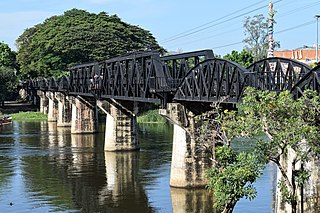
The Burma Railway, also known as the Death Railway, the Siam–Burma Railway, the Thai–Burma Railway and similar names, is a 415 km (258 mi) railway between Ban Pong, Thailand and Thanbyuzayat, Burma, built by the Empire of Japan from 1940–1944 to supply troops and weapons in the Burma campaign of World War II. This railway completed the rail link between Bangkok, Thailand and Rangoon, Burma. The name used by the Japanese Government is Tai–Men Rensetsu Tetsudō (泰緬連接鉄道), which means Thailand-Burma-Link-Railway.

Changi is a planning area located in the geographical region of Tanah Merah in the East Region of Singapore. Sharing borders with Pasir Ris and Tampines to the west, Changi Bay to the southeast, the South China Sea to the east and the Serangoon Harbour to the north. Changi, excluding the two water catchments and islands of Singapore, is the largest planning area by land size.
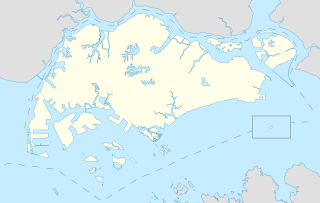
Changi Prison Complex, often known simply as Changi Prison, is a prison in Changi in the eastern part of Singapore.
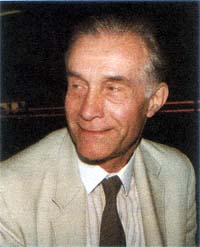
Stanley Warren was an English painter. He was a bombardier of the 15th Regiment of the Royal Regiment of Artillery who became known for the Changi Murals he painted at a chapel during his internment in Changi prison in Singapore during World War II.
A civilian internee is a civilian detained by a party to a war for security reasons. Internees are usually forced to reside in internment camps. Historical examples include Japanese American internment and internment of German Americans in the United States during World War II. Japan interned 130,000 Dutch, British, and American civilians in Asia during World War II.
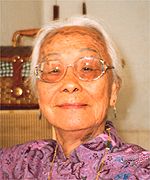
Elizabeth Choy Su-Moi, was a Singaporean educator and councillor who is regarded as a war heroine in Singapore. Along with her husband, Choy Khun Heng, she supplied medicine, money and messages to prisoners-of-war interned in Changi Prison when the Japanese occupied Singapore during World War II.

Batu Lintang camp at Kuching, Sarawak on the island of Borneo was a Japanese internment camp during the Second World War. It was unusual in that it housed both Allied prisoners of war (POWs) and civilian internees. The camp, which operated from March 1942 until the liberation of the camp in September 1945, was housed in buildings that were originally British Indian Army barracks. The original area was extended by the Japanese, until it covered about 50 acres. The camp population fluctuated, due to movement of prisoners between camps in Borneo, and as a result of the deaths of the prisoners. It had a maximum population of some 3,000 prisoners.

Stanley Internment Camp was a civilian internment camp in Hong Kong during the Second World War. Located in Stanley, on the southern end of Hong Kong Island, it was used by the Japanese imperial forces to hold non-Chinese enemy nationals after their victory in the Battle of Hong Kong, a battle in the Pacific campaign of the Second World War. About 2,800 men, women, and children were held at the non-segregated camp for 44 months from early January 1942 to August 1945 when Japanese forces surrendered. The camp area consisted of St Stephen's College and the grounds of Stanley Prison, excluding the prison itself.

The Selarang Barracks incident, also known as the Barrack Square incident or the Selarang Square Squeeze, was a revolt of British and Australian prisoners-of-war (POWs) interned in a Japanese camp in Changi, Singapore.
The "Double Tenth incident" or "Double Tenth massacre" occurred on 10 October 1943, during the Second World War Japanese occupation of Singapore. The Kenpeitai – Japanese military police – arrested and tortured fifty-seven civilians and civilian internees on suspicion of their involvement in a raid on Singapore Harbour that had been carried out by Anglo–Australian commandos from Operation Jaywick. Seven Japanese ships were sunk, but none of those arrested and tortured had participated in the raid, nor had any knowledge of it. Fifteen of them died in Singapore's Changi Prison.

The Changi Murals are a set of five paintings of biblical theme painted by Stanley Warren, a British bombardier and prisoner-of-war (POW) interned at the Changi Prison, during the Japanese occupation of Singapore in World War II (WWII). His murals were completed under difficult conditions of sickness, limited materials and hardships. With a message of universal love and forgiveness, they helped to uplift the spirits of the POWs and sick when they sought refuge in the prison chapel.

The Colditz Cock was a glider built by British prisoners of war for an escape attempt from Oflag IV-C in Germany.
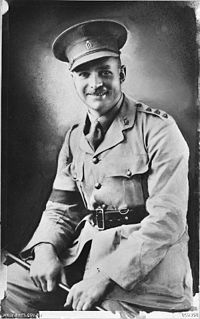
Lionel Colin Matthews, was an Australian Army officer in World War II. He was posthumously awarded the George Cross, the highest award for heroism or courage not in the face of the enemy, that could be awarded to a member of the Australian armed forces at the time. Matthews was born in Adelaide, South Australia, and was schooled there before moving to Victoria. He trained as a signalman in the Royal Australian Naval Reserve before joining the Militia in April 1939. Commissioned as an officer in the Australian Corps of Signals, Matthews transferred to the 8th Division of the Second Australian Imperial Force after the outbreak of World War II.

Changi Air Base or Changi Air Base (West) (Changi West Complex), formerly RAF Changi, is an airfield military airbase of the Republic of Singapore Air Force located at Changi, in the eastern tip of Singapore. Sited at two locations to the east and west of Singapore Changi Airport, it co-shares runway facilities with the civilian airport and currently occupies a third runway slated for future expansion for civilian use by Singapore Changi Airport. Together, the two airfields house 121 Squadron, 112 Squadron, No 145 Squadron, the Field Defence Squadron, the Air Logistics Squadron and the Airfield Maintenance Squadron. The air base badge carries the motto Together in Excellence.

The New Bilibid Prison (NBP) in Muntinlupa, Metro Manila is the main insular penitentiary designed to house the prison population of the Philippines. It is maintained by the Bureau of Corrections (BuCor) under the Department of Justice. As of May 2018, the NBP housed 26,877 convicted criminals.
Eugene Ernest Colman was an English chess master. The son of the architect Ernest Gershom Colman (1851-1935) he graduated from Cambridge University with a law degree and entered service in the Malay States. When he retired, he stayed on in Malaysia and set up youth clubs throughout the peninsula.

George Kenner was a German artist. He made 110 paintings and drawings during the First World War while interned as a German civilian prisoner of war in Great Britain and the Isle of Man.
John ('Jack') George Mennie, A.R.M.S. D.A.(ABDN). ARMS., was a Scottish artist who came to public attention in 2011 for his many contemporaneous drawings of his life as a prisoner of war during the Japanese occupation of Singapore and Thailand in World War II. The drawings were made in secret depicting scenes of daily life and personalities in the camps in Singapore and Thailand, working on the Death railway. They also uniquely documented the Selarang Square Squeeze when some 17,000 prisoners were forced to crowd in the barracks square for nearly five days with little water and no sanitation until they signed a 'promise not to escape'.
Changi Hospital is a now-defunct and abandoned general hospital located in Changi, Singapore. Its closure came with the merging with the former Toa Payoh Hospital and was renamed as the Changi General Hospital, which relocated new operations to nearby Simei, not far from Changi. It began winding down activities in February 1997 and remains abandoned to this day but is out of bounds to the public.
AGH Rostrum Club Changi was a Rostrum Club formed during World War II at the Prisoner of War camp at Singapore's Changi Prison. The club was formed by members of the Australian Army's 13th Australian General Hospital, 8th Division AIF and probably included other allied servicemen.
















